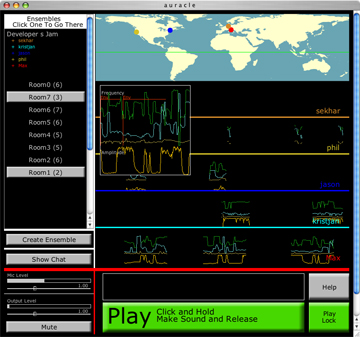Networks
The Networks propose the self-evolution of new musics. Their premise is a form of music-making which remains now only in societies untouched by modern civilization. Rather than something to be listened to, music in these cultures is an activity open to the public at large – a dialogue with sound rather than a performance. I believe this to be the original impulse for music in mankind.
http://www.kunstradio.at/ZEITGLEICH/CATALOG/ENGLISH/neuhaus2a-e.html

Auracle
Auracle is a networked sound instrument, controlled by the voice. It is played and heard over the Internet. Anyone can use it by simply launching it in their web browser at www.auracle.org and creating sounds unaccompanied or with other participants in real time.
It grew out of an interest of mine in the potential of music-making with the lay public over networks. The first realization in this direction was Public Supply in 1966. It arrived whole, as a vision, to make a live sound collage with a general public telephoning in sounds to a New York radio station. Over the next decade, I gradually developed this concept with other realizations and finally in 1977 realized Radio Net, a two-hour nationwide radio event where ten thousand people played a cross-country instrument with their voices.
Ever since Radio Net I had been searching for a way to advance these network ideas from events into a permanent entity. I've had my eye on the Internet for the last fifteen years, but at first it was not in the hands of the general public. Its use was limited to engineers and academics. Then, once it began to be generally used, it still had a fundamental flaw – it was too slow to transmit simultaneous streams of high-quality audio in real time.
In 2000 I realized that I could do it on the web if I didn't try to transmit audio – if, instead, the synthesis was done on each player's machine and only control signals for that synthesis were transmitted over the net. These control signals could easily
be handled by the net in real time, and sound quality would be as good as each player's sound system would allow.
I defined the project in a 'constitution', put together a team with fellowships at the Akadamie Schloss Solitude, asked Phil Burk, the author of the JSyn and Transjam software, to be the technical director and away we went. Although I steered the project with the 'constitution', it was the team members themselves – Jason Freeman, Sekhar Ramakrishnan and Kristjan Varnik – who defined and created Auracle's components. Auracle was inaugurated at the Donaueschingen Musiktage on October 15, 2004.
We are now opening up the design of new Auracle sounds to others. Auracle is an instrument, a system, not a musical composition. We want it to adapt over time in response to how it is used by its players. Right now it is running a preliminary instrument designed by team member Kristjan Varnik. We are in the process of building a plug-in capability to allow outside developers to create new instruments for Auracle. There is a link on the home page where those interested in creating an instrument can sign up.
We want to add a variety of instruments and let players 'vote' which ones to keep by how much time they spend using each one. Incorporating instruments from different programmer/composers will expand the sonic palette of Auracle. Instrument developers can use any type of sound they wish as long as it follows the guidelines of Auracle's constitution.